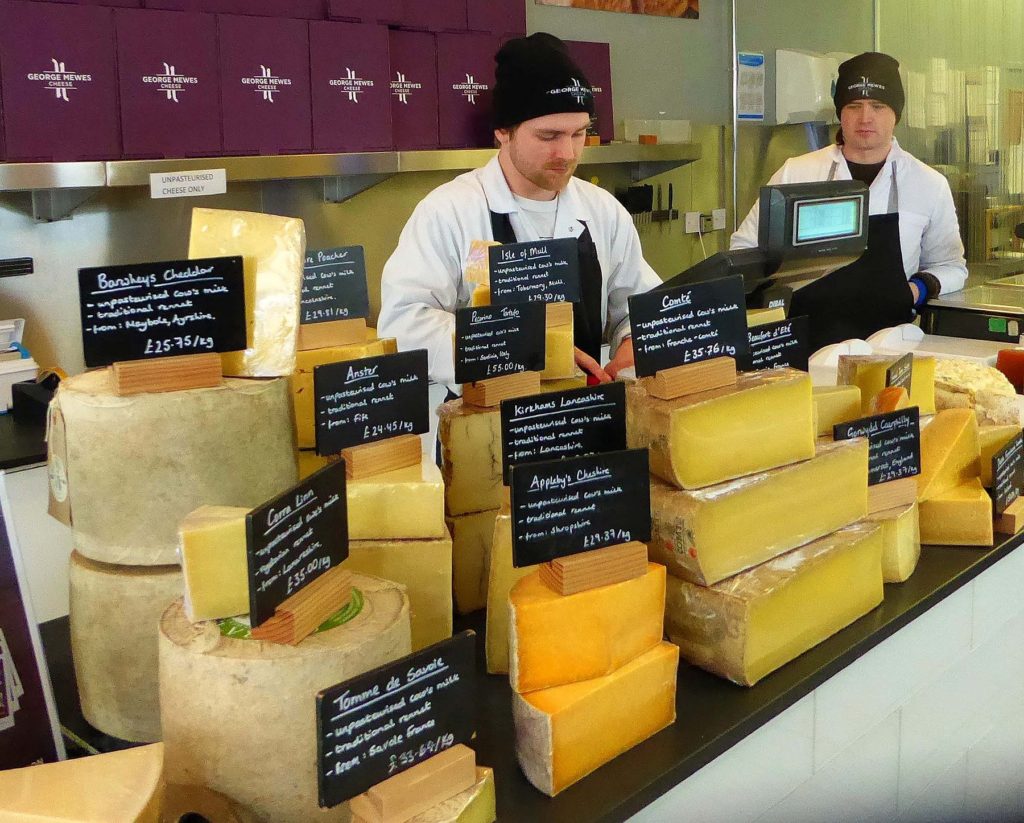Few things make us smile as readily as a taste of great cheese. The best local cheeses represent the apotheosis of milk. A top cheesemaker can take milk from a ewe, goat, or cow and bring out both the characteristics of the breed and the flavors of the place where it grazed. To say that Scotland makes world-class cheese is an understatement. The browse may be scrubby, but the cheeses are rich and layered with subtle flavors.
George Mewes Cheese (106 Byres Road, Glasgow, 0141 334 5900, georgemewescheese.co.uk) launched nearly eight years ago in a modest, temperature-controlled shop in Glasgow’s West End. We stumbled on the shop almost by accident while exploring the neighborhood. We literally smelled the aged cheese aromas wafting out the door before we saw the shop.
Although George Mewes carries a great range of fine cheeses from France, Italy, and the rest of the British Isles, we wanted to taste their Scottish cheeses. Kyle and Mark were tremendously knowledgeable and walked us through the store’s selection. “We are surrounded by artisanal cheesemakers,” Kyle observed, offering us slivers of Bonnet, a firm pasteurized goat’s milk cheese from Ayrshire. The clean, sharp flavor of the hard paste cheese brought our palates alive. At the other end of the flavor spectrum, he proferred one of the legendary traditional ewe’s milk cheeses of Scotland. Lanark Blue dates from the 17th century. It’s a soft, creamy, crumbly blue with very limited bitterness.
Complex Scottish cheddars
The cheddars were a revelation. We started with Barwheys, a raw cow’s milk cheddar from Ayrshire that’s dense and chewy. The initial bitter note soon gives way to rounded tones and some delectable grassy notes. It was a recent winner in the Royal Highland Show—the Scottish cheese, butter, ice cream championships. By comparison, Ayrshire Dunlop, a pasteurized cow’s milk cheese from East Ayrshire, had the texture of rich fudge with a sweet, buttery quality. It was also surprisingly affordable at £20 per kilo (a little under $12 per pound).
Kyle and Marc agreed that “the Scottish cheddars are more complex” than their English counterparts. They finally offered us a taste of Isle of Mull Cheddar, produced on Sgriob-ruadh farm (pronounced Ski-brooah) in Tobermory on the Isle of Mull. (Mull is the second largest island, after Skye, of the Inner Hebrides.) The Friesian cows are fed spent grain from the Tobermory whisky distillery. We didn’t detect any of the smokiness of the Ledaig malt, but we did pick up a nuttiness of the roasted barley, a profound lactic tartness, and the sweet, sweet butter of a great cheddar. A small remaining piece of this cheese is on the board pictured below with our recipe for Scottish oatcake.
Scottish oatcakes complement cheese
 Oatcakes or “bannock” are a Scottish classic. They are the perfect complement to Scottish cheddar cheese, though many people also like them with butter, jam, or clotted cream. British recipes for oatcakes abound on the Internet, but they all call for ingredients that are hard—sometimes impossible—to get in North America. “Oatmeal” to a Brit means an entirely different product than it does to an American or Canadian.
Oatcakes or “bannock” are a Scottish classic. They are the perfect complement to Scottish cheddar cheese, though many people also like them with butter, jam, or clotted cream. British recipes for oatcakes abound on the Internet, but they all call for ingredients that are hard—sometimes impossible—to get in North America. “Oatmeal” to a Brit means an entirely different product than it does to an American or Canadian.
After some bumbling attempts making oatcakes that even the birds wouldn’t eat, we took the lead of Christina Conte, who writes the wonderful Christina’s Cucina blog (www.christinascucina.com). She uses a different technique, but she gave us the idea of grinding our own oat flour from commercially available oat groats. We use a Krups coffee/spice grinder, which will grind a bit more than a half cup at a time.
We sometimes purchase groats in bulk from our local coop, but they are readily available in most large grocery stores as McCann’s Steel Cut Irish Oat Meal. (They’re also essential to making a good Irish brown bread. Here’s our recipe for that.)
SCOTTISH OATCAKES
Ingredients
240g (8 1/2 oz.) steel cut oat groats
1/2 teaspoon sea salt
28g (1 oz.) butter
1/4 teaspoon baking soda
6-7 tablespoons very hot water
Directions
Set oven to 375°F.
In a coffee/spice grinder, process the groats until they are reduced to flour with a few coarse bits—like commercial cornmeal. Reserve 1/2 oz. of the oat flour.
Place 8 oz. oat flour in a food processor with salt, butter, and baking soda. Process until butter is incorporated. Add 6 tablespoons of just-boiled water and continue to process. Add a little more if needed to make the sticky dough cohere.
Sprinkle the reserved oat flour onto work area. Divide the dough in two parts. Flatten one ball and cover with a piece of plastic wrap. Roll out until it’s about 1/4 inch thick. Remove wrap, shore up the rough edges, and cut into 6 triangles. Repeat process with second ball.
Using a cake server, lift each triangle to sheet pan lined with Silpat or parchment paper. Bake for 20-25 minutes, until edges just begin to brown. Cool on rack. Store in closed container.

